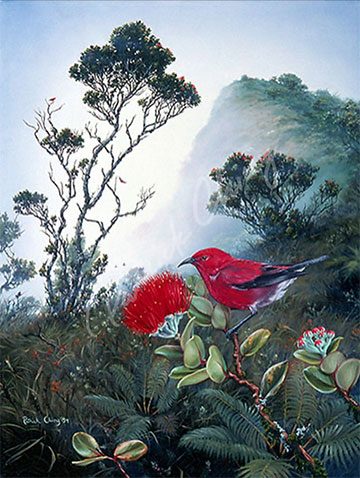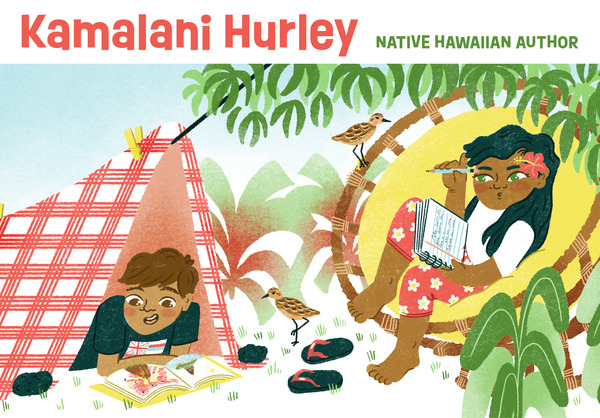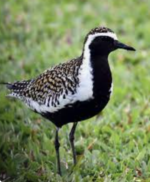
Native Hawaiian author Kaylin Melia George has always been a storyteller. She began her career as a screenwriter and is now a children’s author. Her debut picture book, Aloha Everything, is the fulfillment of a lifelong dream: to share the rich stories she grew up hearing at her mother’s side. We are pleased to talk story with Kaylin today.
For those who haven’t met you yet, please tell us a little about yourself.
Aloha, I’m Kaylin Melia George; and I’m the author of Aloha Everything!
Growing up, I called many places home. My family moved around frequently, and I attended many different schools from the Pacific Northwest, to the South, to the Midwest, to the Southwest, and the West Coast. I also lived in Tokyo for a period. But as much as I moved around, my connection to my family – and my family’s stories – has always been one of the few constants in my life.
I’ll always remember falling asleep to my mother’s beautiful bedtime stories. She would tell me of Hawaiian legends and histories passed down to her from generations before. She would also share her own experiences growing up on Molokaʻi – how she adventured on the islands, how she performed hula, and how her and her cousins would get in and out of mischief together. The planting of these early seeds inspired me to dedicate my life to storytelling. It’s become an important part of who I am and the stories I tell.
Why did you become an author? Have you always wanted to be an author?
When I was a little girl, my dream was to become an author. However, I realized from a pretty young age that my family’s stories weren’t present on the bookshelves of my schools or libraries. As I grew up, I learned that is because Pacific Islander is one of the least represented groups in children’s literature. But, I still dreamed of writing! I ended up starting in screenwriting – working for many years as an award-winning director and screenwriter of commercials, films, and documentaries. I eventually found my way back to my childhood dream with my debut children’s book, Aloha Everything! I’m deeply grateful for all the people who made this book possible and all the people who have become a part of the Aloha Everything ʻohana. I wrote this book with the hope of sharing and preserving my family’s stories, and I believe it will be the first of many to come.
What do you enjoy most about writing, especially for kids? What are some of your greatest challenges?
There’s a huge responsibility that comes with the creation of a book like Aloha Everything – a responsibility to the accuracy and the tonality of the representation of Hawaiʻi-based stories. That’s a challenge. I do not pretend that the book could, on its own, represent even a sliver of the full breath of beauty, depth, and vibrancy of what Hawaiian culture, history, and life truly is in full. But, I know that Aloha Everything has an impact. There’s nothing more breathtaking than seeing keiki fall in love with the story and become interested in learning more about Hawaiʻi and Hawaiian culture. And because Pacific Islander stories are so rarely represented in children’s literature, meeting keiki who feel personally connected with the book – who feel that they are seeing their home represented – those are incredibly special moments.
Can you share a bit of your upcoming debut picture book, Aloha Everything? Without giving too much away, what is it about?
Aloha Everything is a journey of adventure and learning. Within its pages, you’ll encounter mighty canoes crashing over ocean waves, royal hawks soaring high above the clouds, and, most importantly, you’ll meet a courageous young girl who learns, grows, and comes to love her island home with all her heart. In the book, knowledge surrounding Hawaiian history, ecology, and culture is carefully woven into a beautiful rhyming scheme that will lull little ones into brilliant dreams of vibrant adventure.
What characteristics do you love best about the protagonist? Is she modeled after someone specific?
From the beginning, my mother’s stories about growing up on Molokaʻi were a huge inspiration for the story. So, when we were designing our protagonist, it felt only natural that the character be partially modeled on my mother herself. Mae Waite (the incredible illustrator of Aloha Everything) and I referenced old photographs of my mom growing up on the islands. We were looking to capture landscapes, flora, and animals to reference in the book. But, even more importantly, we were looking to capture the spirit of a little girl who deeply loves her island home.
I remember one photograph in particular that was heavily referenced. It’s my mom as a little girl, and someone was clearly trying to catch her with the camera, but she shows up a little blurry because she just wouldn’t stay still for the photo! Even with the blurriness of the photograph, the one thing that’s absolutely clear is the image of a child who is full of energy and adventure and excited to be outside and taking in the joy of the islands. That’s a feeling that we try to recreate in every illustration of Ano, the protagonist of Aloha Everything.
What was your favorite part of writing your book?
We always dreamed that the story would be not only an exhilarating adventure but also an opportunity for learning. That’s why, while the book was still in early stages of development, we consistently consulted with teachers, parents, and, of course, with kids themselves. We brought the book into over a dozen classrooms and to nonprofit readings to see students of every age experience the book, and that was definitely one of my most favorite parts of the process. Seeing keiki as young as preschool age and as old as fifth grade all deeply engaged and learning and interacting with the book in different ways has truly been such a remarkable gift. I met students who were so joyful to see Hawaiian words they recognized included in a book for them. I met other students that were so excited to learn Hawaiian words for the first time. Those experiences, and seeing the genuine excitement in students’ eyes, are something I’ll cherish forever.
I must also say that as much as I hope that Aloha Everything will be an awesome learning experience for kids everywhere, certainly no one has learned more from creating this book than I did. And that is most definitely my other favorite part of writing the book.
Growing up away from the islands, I always learned about my Native Hawaiian heritage from my mother’s stories. But through the creation of this book, I found an opportunity to seek out new learnings in a whole new way. I was having new conversations with my family about our histories and our heritage. I was interviewing inspirational and influential kumu. I was spending years in reading and research. And I was having the most incredible interactions with members of the community who have been so kind as to share with me their personal stories and their manaʻo. It has been truly transformative for me; I was constantly learning new things about myself that I had never known. And I am so grateful for that journey and everyone who has made it possible.
Can you tell us about the writing style of Aloha Everything?
Aloha Everything is a poetry book primarily written in anapestic meter with a simple rhyme scheme. It’s a multilingual book, sometimes called a “language-mixing” book, as it’s written in English but features twenty-five Hawaiian words to learn. I decided to write the book in this style for a few different reasons but especially because rhyming and poetry have been shown to have a positive effect on memory and learning, and I hope that the rhythmic nature of the text makes it easier for some students to learn the Hawaiian words included in the text.
We’ll post an interview with Mae coming up in a couple of weeks, but what can you say about the medium for the book’s illustrations?
Mae worked with mixed physical mediums for the creation of the illustrations. She used acrylic, gouache, and gold leaf. Each illustration started as a sketch, and she went through, usually, a dozen or more iterations until we knew that it was as good as it could be. Then painting would begin. Each extraordinary painting was created meticulously over the course of weeks, and we put so much love into each and every piece, which is what makes them all so spectacular.
Do you have any experiences as a Native Hawaiian writer that you might share with our readers?
When I was young, I very rarely ever saw families like my own represented in the pages of a book. That impacted my idea of what kind of people could build careers in this industry. I had such a love for storytelling, but I was afraid that no one wanted to hear my stories.
However, I am no longer afraid. When Aloha Everything launched on Kickstarter, I found a community who gave us so much support, pushing us into the top 50 most successful children’s books to ever launch on the platform – out of 12,000 books! I believe that all the support Aloha Everything found goes to show that not only are these stories needed, but also that they’re desired and beloved by readers.
As long as readers continue to support stories that are important to them, I feel very hopeful about what bookshelves will look like for future generations.
You decided to crowd-fund your book. Why did you choose that route to publication? What was the journey to getting your book published like? How long did it take to write your book?
It took about three years to complete Aloha Everything. Mae and I worked on the book with a new and innovative independent publisher called Mythify. Because Aloha Everything was a first book for everyone involved, we had no idea what demand for the book would be like. For all we knew, we could have been making the book for only a handful of people, and we were okay with that! But that’s the reason why we decided to use Kickstarter as a pre-order platform; it allowed us to estimate demand. And it’s a good thing that we did, because we received so many more orders than we ever could have imagined! We never would have printed enough books to cover demand if we hadn’t used a platform like Kickstarter for pre-orders first. Through Kickstarter, we really found a community of people who love and support our story, and we are so grateful for that. Additionally, I’m so excited to say that there are more wonderful things coming soon for Aloha Everything! Mythify and the Aloha Everything team have now partnered with a publisher called Red Comet Press to create a retail edition of the book. Aloha Everything will be launching for retail on large platforms such as Amazon, Barnes & Noble, and Target in Spring of 2024. I am so looking forward to this part of the journey and the opportunity to make the book available to more keiki!
Can you share a bit about what you’re working on next?
One of the most amazing parts of creating Aloha Everything was meeting Mae. She truly is an incredible collaborator and an amazing friend. And while I can’t say too much yet about my future projects, I can say that I absolutely look forward to working with Mae again soon!
What advice would you give aspiring writers?
Have patience with yourself; you’re learning! Each and every project will always be different and you’ll always be learning new things. It’s okay to take your time as you grow as a creator. This is something I’ve definitely learned over time
A couple of niele personal questions, please. Who is your biggest supporter?
Ultimately, I have to say that my all-time biggest supporter must be my mother. All my life, she has encouraged my writing and my passions. I’m so grateful that she trusted me to tell her story and that she shared so much of her kōkua and her aloha in the creation of the book
Is there a fun fact youʻd like to share about yourself with young readers?
Because Aloha Everything is so bright and colorful and vibrant, people are sometimes surprised to learn that I’m a huge lover of everything spooky! I’m a haunted house lover, a horror movie addict, and a Halloween fanatic. Maybe one day, Mae and I will bring something both spooky and cute to the children’s lit world!
That’s cool! What’s your online presence? And how can readers show their support?
I am available on social media, and I absolutely love to connect!
@alohaeverythingbook is on Instagram, TikTok, and Facebook. But the quickest way to contact us is via email at alohaeverything@mythify.com!
I’m so grateful for all the people who have been kind enough to reach out and share their stories with us. Receiving those encouraging messages makes all the challenges of book publishing worth it!
If you’ve read Aloha Everything, please consider leaving us a review on GoodReads or elsewhere, as it really helps us get the word out. Mahalo nui loa!
It was so fun meeting you, Kaylin! Mahalo for sharing your mana’o with us! To learn more about Kaylin and to pre-order her book, visit her Kickstarter website, Aloha Everything: A Hawaiian Fairy Tale.
Images courtesy of Kaylin Melia George.













 First there are three, for a reason. Three is my favorite number. Lots of things come in threes — three wishes, the triple crown, three parts of an atom, three-part story structure, three musketeers, junkenpo — but most important to me are my three daughters.
First there are three, for a reason. Three is my favorite number. Lots of things come in threes — three wishes, the triple crown, three parts of an atom, three-part story structure, three musketeers, junkenpo — but most important to me are my three daughters. Kōlea tend to return to the same Hawaiʻi neighborhoods each year, and Iʻm always happy when I see them on our Central Oʻahu street. I can tell theyʻre around when I hear their distinctive keek-KEEK!
Kōlea tend to return to the same Hawaiʻi neighborhoods each year, and Iʻm always happy when I see them on our Central Oʻahu street. I can tell theyʻre around when I hear their distinctive keek-KEEK!